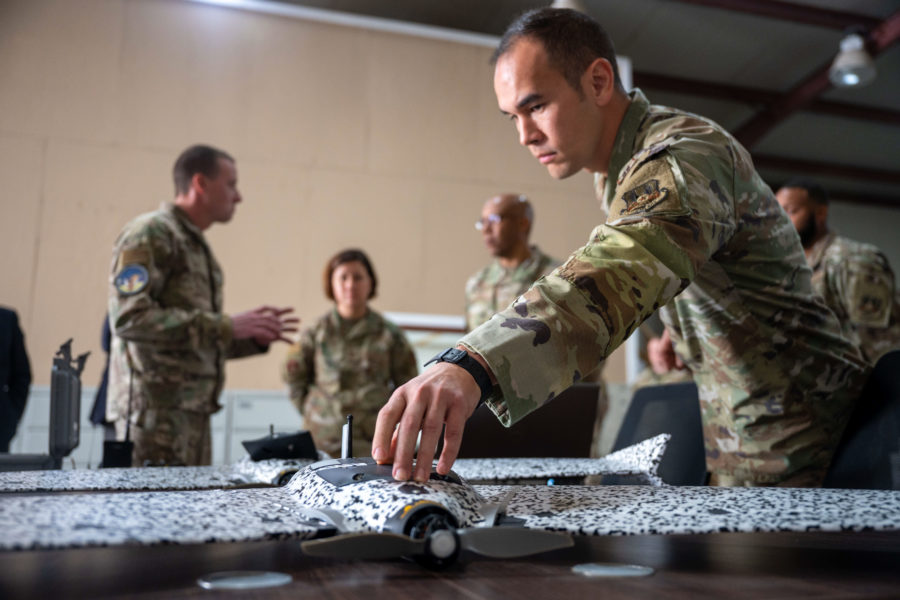The Air Force’s Task Force 99, a showcase unit defense officials have cited as a model of how to make the most of existing resources in the Middle East, recently concluded its first operational experiment, a successful test of using small drones for intelligence, surveillance, and reconnaissance roles, Air Forces Central (AFCENT) leaders said.
The task force is designed to help AFCENT to do more with less in the Middle East. After decades as the highest-priority theater, today both the Pacific and Europe are increasingly gaining priority. AFCENT leaders intend to as part of a new drive to experiment throughout U.S. Central Command and adopt a “culture of innovation.”
“Depending on the on the systems we’re bringing in, that will always be an ongoing process,” Col. Robert Smoker, the task force commander, told Air & Space Forces Magazine Feb. 24. “But we are at the point now where we have actually done our first operational evaluation in theater.”
Smoker said the team tested a small commercial drone with a “mapping capability,” and which he called promising. “It performed admirably and as advertised,” Smoker said. “So it looks like it could be good for potential use in the future for folks at AFCENT.”
Speaking at an AFA Warfighters in Action event Feb. 13, Lt. Gen. Alexus G. Grynkewich, the AFCENT commander, said the test was part of a broader effort to “fill some of the gaps that we have as our other more traditional ISR platforms have gone to other regions or other priorities for the Air Force.”
“So we’re trying to solve our own problems,” Grynkewich added. “And we’re trying to do it in a way that’s less expensive and that is, frankly, in many cases more effective than we might have been able to do [before].”
Task Force 99 plans to next test more complex drones and will start joint experiments with Navy Task Force 59 to test long-range unmanned aerial systems in March.
“The Navy problem was maritime domain awareness,” Gynkewich said. “Our problem was air domain awareness, and air domain awareness not just for tracking objects in the air, but maybe finding things on the ground that launch into the air, and how those could be a threat to us.”
Smoker, an Air National Guard Airman whose civilian job is in the defense industry, took command of Task Force 99 Feb. 23, relieving Lt. Col. Erin Brilla at the end of her CENTCOM tour.
Established in October 2022 with a focus on testing products costing from a few hundred dollars up to $75,000, the Task Force includes just nine Airmen, including Smoker.
“The ultimate goal with these operational evaluations is to determine that this thing does work as advertised, and it works in the environment in which we want it to operate,” Smoker said.
Grynkewich said he is giving Task Force 99 a long runway to experiment as “super-empowered” Airmen. CENTCOM envisions all services working together on these experiments, with the goal of increasing awareness of all threats in the region. The Navy already employs a deployed network of surveillance vessels as part of Task Force 59. The Army stood up its Task Force 39 in November 2022, with one of its focuses being counter-UAS solutions.
AFCENT hosted an innovation day at Shaw Air Force Base, S.C., headquarters on Feb. 15, bringing in more than 70 industry partners for an event hosted by Grynkewich.
“It’s a dangerous region, and there are people attacking us every day,” Grynkewich said at the time. Both Iran and ISIS have used drones to attack American assets and partners in the Middle East, and Iran’s drone threat has prompted the U.S. to call in F-22 Raptors to deploy to the region multiple times. U.S. troops in Syria face particularly acute risks from drones, and are using new counter-UAS systems to augment their defenses.
“We’ve got the best operators on the ground intercepting these threats,” Grynkewich said. “But we can’t always rely on that, which is why we need to be able to provide new technologies and new approaches in new ways that increase the length of time we have to engage.”
